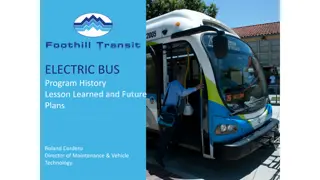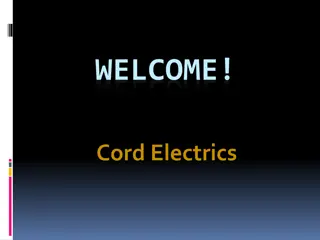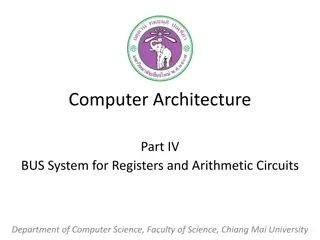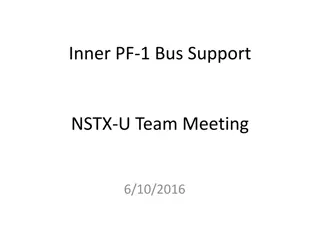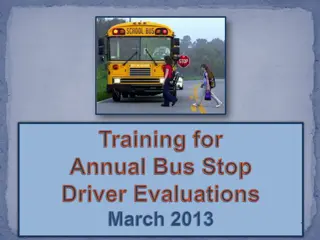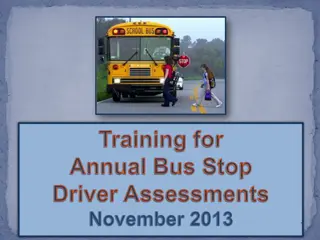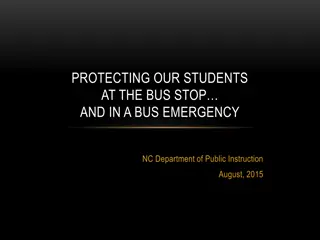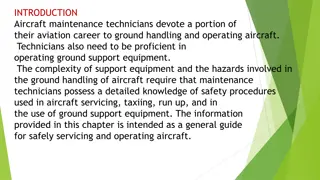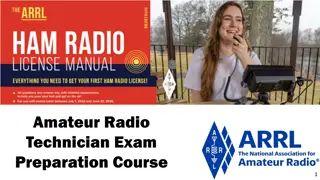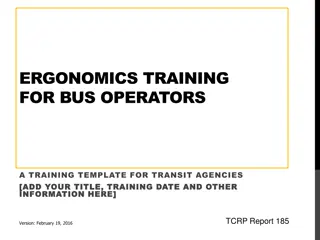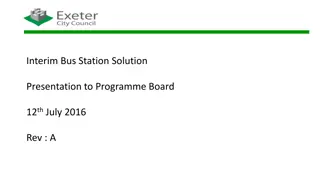Bus Maintenance Electrical Safety Program
This program aims to create safe work conditions for OC Bus Maintenance personnel handling electric buses. It outlines principles, training, qualifications, protective equipment standards, and procedures for working with high voltage systems. Definitions include terms like qualified, certified, high voltage, and competent persons according to OSHA standards.
Download Presentation

Please find below an Image/Link to download the presentation.
The content on the website is provided AS IS for your information and personal use only. It may not be sold, licensed, or shared on other websites without obtaining consent from the author.If you encounter any issues during the download, it is possible that the publisher has removed the file from their server.
You are allowed to download the files provided on this website for personal or commercial use, subject to the condition that they are used lawfully. All files are the property of their respective owners.
The content on the website is provided AS IS for your information and personal use only. It may not be sold, licensed, or shared on other websites without obtaining consent from the author.
E N D
Presentation Transcript
Maintenance & Training On Zero Emission Buses CALACT Spring Conference April 19-22, 2022 Newport Beach, CA
Maintenance & Training On ZEBs How do we get there from here . 1. A written Electrical Safety Program is required 2. Personnel must be trained, Qualified, and Authorized 3. Protective equipment and proper tools are required 4. Procedures must be written, in compliance, and all work must be documented. 2
Bus Maintenance Electrical Safety Program Purpose of Electrical Safety Program The purpose of this program is to establish electrically safe work conditions for OC Bus Maintenance personnel servicing and maintaining OCTA s fleet of electric buses. This written plan identifies principles and practices for working safely with electrical hazards, establishes training and qualifications for maintenance personnel, identifies standards for personal and other protective equipment, and spells out the process for authorizing high voltage (HV) work. 3
Bus Maintenance Electrical Safety Program Definitions Qualified Person. One who has received training in and has demonstrated skills and knowledge of the proper use and care of HV PPE, the OCTA Bus Maintenance HV Lockout Tagout procedure, and the operation of HV bus electrical systems, preventive maintenance, service procedures, and troubleshooting, and the hazards involved. 4
Bus Maintenance Electrical Safety Program Definitions Certified Person. Someone who has passed exams from an accredited organization related to the work that he or she will perform. 5
Bus Maintenance Electrical Safety Program Definitions High Voltage (HV). Within the context of this program, any form of voltage greater than or equal to 50 volts. (NFPA 70E 110.3 Electrically Safe Work Condition) 6
Bus Maintenance Electrical Safety Program Definitions Competent Person. One who is capable of identifying existing and predictable hazards in the surroundings or working conditions that are unsanitary, hazardous, or dangerous to employees and who has authorization to take prompt corrective measures to eliminate them. (Source: OSHA United States Department of Labor, Occupation Safety and Health Administration, Occupational Safety and Health Standards Number 1910.399, Definitions applicable to this subpart) 7
Bus Maintenance Electrical Safety Program Scope of Electrical Safety Program Identification of electrical hazards associated risks, and safety standards. Determination of boundaries and applicable personal protective equipment requirements. Identification of visual warning prompts which provide information of exposure potential. Qualification requirements for personnel performing maintenance or service on High Voltage bus equipment, including training, performance, and testing requirements. Identification of necessary tools, supplies, and equipment. Job safety planning Incident investigation 8
Bus Maintenance Electrical Safety Program Principles of Electrical Safety Program 1. Ensuring employee qualifications and assessment of abilities, only Qualified and Authorized personnel allowed to maintain or service HV systems. 2. Protecting employees from electric shock, arc flash, and other hazards 3. Using the correct tools 4. Planning all tasks and documenting first-time procedures 5. Identifying hazards and minimizing risks: 1.Analyze job before starting work, identify potential hazards, and take necessary safety precautions 2.Follow OCTA Standard Operating Procedures and manufacturer s service guides and warnings. 3.Anticipate unexpected events 9
Bus Maintenance Electrical Safety Program Principles of Electrical Safety Program (continued) 6. Establishing an electrically safe work condition (NFPA 70E 120.5).Work on De-energized equipment, if possible. 7. Regular inspection and maintenance of electrical equipment, insulation, and the integrity of protective barriers must be a high priority to minimize personnel exposure to hazards. 8. Working Live. It is always important to perform the maximum amount of HV service in the de-energized state. 9. Ongoing evaluationand improvement of work procedures, principles, and safety practices 10. Accountability. All HV work must be planned as a team and approved 10
Bus Maintenance Electrical Safety Program Risk Assessment Shock Hazard Risk Assessment per NFPA 70E 130.4 using table 130.4(E)(a) for Alternating Current and 130.4(E)(b) for Direct Current Voltage to determine the shock hazard and applicable protection approach boundaries. Arc Flash Risk Assessment of incidental energy performed and provided by the bus manufacturer or OEM shall determine the Arc Flash hazard boundary and required PPE. 11
Bus Maintenance Electrical Safety Program Labeling High voltage bus equipment, including energy storage systems, components, contactors, circuit protection devices and enclosures, that are likely to require examination, adjustment, servicing, or maintenance while energized shall be marked with a label that conforms to NFPA 70E 130.5(H) standards. 12
Bus Maintenance Electrical Safety Program Training and Qualifications To create electrically safe work conditions for all maintenance personnel, OCTA management is committed to providing a level of training for each employee appropriate to their job responsibilities. All maintenance employees are to receive High Voltage (HV) Awareness and Safety training. Mechanics working on HV systems must be qualified and authorized by the Authority before performing any preventive maintenance or repairs. A supervisor and manager overseeing the work of HV qualified mechanics must be qualifiedand considered a competent person, capable of identifying existing and predictable hazards and able to take prompt correct action to eliminate them. 13
Bus Maintenance Electrical Safety Program Training and Qualifications (continued) Two (2) levels of training are required to help establish an electrically safe work environment for OCTA maintenance employees. A. Unqualified Personnel Level I Shall be trained in, and be familiar with, any electrical safety-related practices necessary for their safety or the safety of those they manage. B. High Voltage Qualified Bus Maintenance Supervisor or Manager Level II Only trained and qualified personnel shall supervise and manage work performed by HV Qualified Mechanics. 14
Bus Maintenance Electrical Safety Program Training and Qualifications (continued) A High Voltage Qualified Bus Maintenance Supervisor or Manager must complete at minimum the following training: a)Current HV Supervisor/Manager Level II Training b)PPE Use and Care Training c) LOTO and Zero Voltage Verification Training d)Electrically Safe Work Practices and Procedures for Bus Mechanic Electrical Worker HV Arc Flash Training e)Emergency Response, First Aid, CPR, and AED Training f) Safe Contact Release Training, annual refresher training required. 15
Bus Maintenance Electrical Safety Program Training and Qualifications (continued) A High Voltage Qualified Bus Maintenance Supervisor or Manager must demonstrate and be tested on the following skills: a)Knowledge of the proper use of and care of High Voltage PPE, including testing requirements. b)Knowledge of OCTA Bus Maintenance HV Lock out Tag Out procedure including Zero Voltage Verification c) Knowledge of OCTA Bus Maintenance Electrical Safety Program Work Practices and Procedures 16
Bus Maintenance Electrical Safety Program Training and Qualifications (continued) C. High Voltage Qualified Bus Mechanic Level II One who has received training in and has demonstrated skills and knowledge of the proper use and care of HV PPE, the OCTA Bus Maintenance HV Lock out Tag Out procedure, the operation of HV bus electrical systems, preventive maintenance, service procedures, and troubleshooting, and can identify the hazards involved and minimize associated risks. 17
Bus Maintenance Electrical Safety Program Training and Qualifications (continued) A High Voltage Qualified Bus Mechanic must complete at minimum the following training: a)Current HV Mechanic Level II Training b)PPE Use and Care Training c) LOTO and Zero Voltage Verification Training d)Electric Safe Work Practices for Bus Mechanic Electrical Worker HV Arc Flash Training e)Emergency Response, First Aid, CPR, and AED Training f) Safe Contact Release Training, annual refresher training required. 18
Bus Maintenance Electrical Safety Program High Voltage Qualified Bus Mechanic must demonstrate and be tested on the following skills: a)The proper use of and care of High Voltage PPE, including testing requirements. b)The OCTA Bus Maintenance HV Lock out Tag Out procedure including Zero Voltage Verification c) Knowledge of OCTA Bus Maintenance Electrical Safety Program Work Practices and Procedures 19
Bus Maintenance Electrical Safety Program Training Requirements Employees will be provided training to obtain necessary qualifications and retraining as required by this program. Each subject area listed above must include refresher training at intervals not to exceed three (3) years. Training records will be retained in the OCTA Saba TalentSpace learning management system per NFPA 70E 110.6(A)(5) requirement and be readily available to management and supervisors overseeing HV work. 20
Bus Maintenance Electrical Safety Program Additional training and retraining is necessary when Inspection indicates employee not properly complying with safety related work practices New equipment, including PPE, or new technology is introduced New or revised procedures are to be used Scheduled for task not associated with regular job duties Retraining has not occurred within 3 years Requested by employee 21
Bus Maintenance Electrical Safety Program Personal Protective Equipment (PPE) The primary method required to protect an employee from an electrical hazard(s) is to place equipment in an electrically safe work condition (ESWC). Until an ESWC is established, an employee must be properly protected from all exposed electrical hazards. OCTA will provide and maintain all required Personal Protective Equipment. 22
Bus Maintenance Electrical Safety Program Other Protective Equipment (OPE) Standards for Other Protective Equipment (OPE) required in NFPA 130.7(D) shall conform to the applicable state, federal, or local codes and standards. OPE includes, but is not limited to, Insulated Tools and Equipment, Barriers, including rubber insulating equipment and physical or mechanical barriers, Barricades, and Safety Signs and Tags. (See item C below and Table in Appendix B for more detailed information) 23
Bus Maintenance Electrical Safety Program Insulated Tools and Equipment Tools and equipment used to support this program will be provided for by OCTA Maintenance, including calibration as required. Tools or equipment used within the restricted approach boundary shall be insulated and rated for the voltages on which they are used, at minimum 1000 Vac or 1500 Vdc for High Voltage circuits. Insulated tools shall be protected from damage to the insulating material. 24
Bus Maintenance Electrical Safety Program Job Safety Planning Before starting each job that involves exposure to electrical hazards, the HV Qualified Maintenance Supervisor and HV Qualified Mechanics, both Checker and Monitor, shall complete a written job safety plan in three parts: 1) HV Work Briefing 2) Energized Electrical Work Permit 3) Zero Voltage Verification Checklist 25
Bus Maintenance Electrical Safety Program HV Two-Person Safety Rule Two (2) High Voltage Qualified Bus Mechanics are required, one called the Checker, the other called the Monitor, to perform preventive maintenance, servicing, and troubleshooting procedures. Working together, to ensure the safety of themselves, others nearby, and the protection of vehicle and property 26
Bus Maintenance Electrical Safety Program Review of Job Safety Plans Job Plans shall undergo periodic review of critical steps and approaches to ensure they are current, relevant, and in use. Reviews will be conducted on a yearly basis or as changes to the Job Plan occur, whichever comes first. Revision dates are to be clearly identified in lower left corner of Job Safety Planning documents. 27
Bus Maintenance Electrical Safety Program Incident Investigation OCTA shall investigate all electrical incidents. The focus of an investigation. Electrical incidents include events or occurrences that result in, or could have resulted in, a fatality, an injury, or damage to health. Incidents that do not result in fatality, injury or damage to health are commonly referred to as a close call or near miss. Investigation of near miss provides an opportunity to identify a hazard associated with the near miss and to potentially avert a more serious incident in the future. 28
Bus Maintenance Electrical Safety Program Compliance This Bus Maintenance Electrical Safety Program shall be reviewed and evaluated to verify that the principles and procedures of the program are in compliance with current NFPA 70E standards. All reviews and enforcement actions are to be documented for the benefit of the employees and of the OCTA Maintenance Department. All reviews and evaluations required by the Bus Maintenance Electrical Safety Program shall be documented. NFPA 70E 110.5(M) 29
SUMMARY SUMMARY Strategy and Action Steps Procedures Procedures Written / Documented / Routine Protection Protection PPE / OPE / Tools People People Workforce Development Plan Plan Bus Maintenance Electrical Safety Program 32



